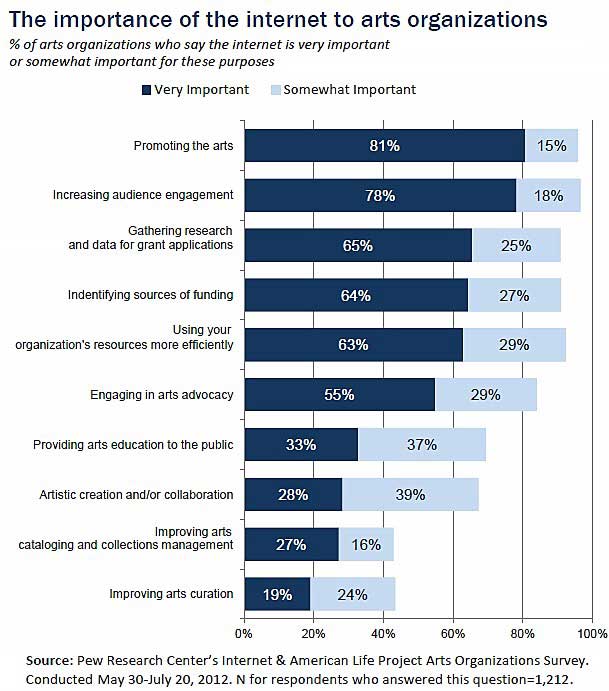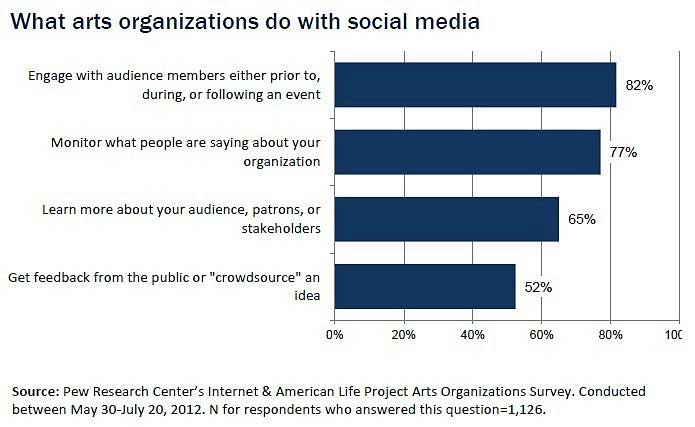The Internet, social media, and mobile connectivity now permeate the operations of US-based arts organizations, changing the way they stage performances, mount and showcase exhibits, engage audiences, sell tickets, and raise funds, according to new report by Pew Research.
The study is based on interviews with some 1,244 arts organizations that have received funds from the National Endowment for the Arts (NEA) in recent years.
Such organizations are even finding that technology has changed the very definition of art: 77% agree with the statement that the Internet has "played a major role in broadening the boundaries of what is considered art."
Below, additional findings from the January 2013 report titled "Arts Organizations and Digital Technologies," issued by the Pew Research Center's Internet & American Life Project on January 4, 2013.
Arts Events
Presenting and hosting events is a core function of arts organizations: 94% of those surveyed say they host or sponsor in-person events or exhibits, and 29% say they host online events, such as webinars, virtual performances, and virtual exhibits.
Among those 29%, nearly 9 in 10 (86%) say the number of online events has increased over the past several years, and another 12% say the number had stayed the same.
Perceived Value of Technology
Nearly all leaders of arts organizations (97%) report that the Internet and digital technologies are very important or somewhat important to various aspects of their work.
Among those 97%, most say the Internet and digital technologies are "very important" for "promoting the arts" (81%), "increasing audience engagement" (78%), and funding-related work (65%).

Only 27% of the organizations surveyed say the Internet is "very important' for improving arts cataloging and collections management, and 19% feel it's "very important" for improving arts curation.
However, those findings are more an indication of the differences in arts organizations' objectives rather than a dismissal of the internet’s value, Pew notes.
Adoption of Digital Technologies
Clearly, arts organizations are plunging into digital technology:
- 99% of arts organizations have their own website.
- 86% accept donations online.
- 72% sell tickets online.
- 47% sell merchandise online.
- 34% make information about their organization available through RSS feeds.
- 31% offer discounts through online services such as Groupon or Living Social.
- 27% host podcasts.
Social Media
Most arts organizations are also using some type of social media:
- 97% have a social media presence on Facebook, Twitter, YouTube, Flickr, or another other platform.
- 69% have individual employees who post to their own social media profiles in their capacity as a representative of the organization.
- 45% of the organizations with a social media presence say they post updates daily, including 25% who post updates several times a day.
- 50% publish a blog.
Top Social Channels
Among those organizations using social media, Facebook is the most popular channel with 99% reporting a presence on the site. Next is Twitter, used by 74% of organizations, followed by YouTube at 67%, Flickr (38%), LinkedIn (31%), Wikipedia (27%), Vimeo (23%), Foursquare (20%), and Yelp (19%).
How Social Is Used
Arts organizations that use social media are using the platforms for a range of activities:
- 82% say they engage audiences before, during, and after events.
- 77% use social networks as a social barometer, to monitor what patrons and the public are saying about their organizations.
- 65% use the tools to learn more about their patrons via more direct communications, as well as online surveys and polls.

In addition, more than one-half of organizations (52%) have used social media to crowdsource an idea, from possible programming decisions to the best times for sessions or seminars.
Social Media's Perceived Impact
Some 56% of the social-media-using organizations say it has a "major impact" on boosting their organization’s public profile, while 53% say it has a "major impact" on their engagement with the public.
Social media are also viewed by many organizations as helping them increase their website traffic (48%), promote events (45%), and build audiences (41%).
Such social platforms are more often described as having a "minor impact" on fundraising (13%), product sales (11%), and public education (16%).
Mobile Apps
Mobile connectivity is beginning to drive activity in arts organizations: 24% of those surveyed say they use apps to provide content to the public; 17% say they use apps to facilitate work in their own organization; 15% use apps to sell tickets or services; 5% use apps to train and educate employees.
Concerns
Arts organizations have concerns about technology as well:
- 40% agree with the statement that digital technology is "negatively impacting audience members' attention spans for live performances," including just 9% who strongly agree this is the case.
- 22% strongly or somewhat agree with the statement that digital technologies are "hurting arts organizations by decreasing attendance at in-person events."
- 10% strongly or somewhat agree with the statement that "the Internet and digital technologies are diluting the arts by giving everyone interested in the arts and arts criticism a public platform."
One other impact is cited prominently by many of the organizations: 37% strongly agree (and another 34% somewhat agree) that "digital distractions such as ringing cell phones and audience member texting are a significant disruption to live performances."
About the data: Findings are based on an online survey of 1,244 arts organizations that have received funds from the National Endowment for the Arts (NEA) from 2006 to 2011, conducted by the Pew Research Center's Internet & American Life Project among a diverse sample including respondents from visual arts, music, theater, dance, literature, from May 30 to July 20, 2012. Published on January 4, 2013, The report was authored by Kristin Thomson, Research Consultant; Kristen Purcell, Associate Director for Research, Pew Internet Project; and Lee Rainie Director, Pew Internet Project.




